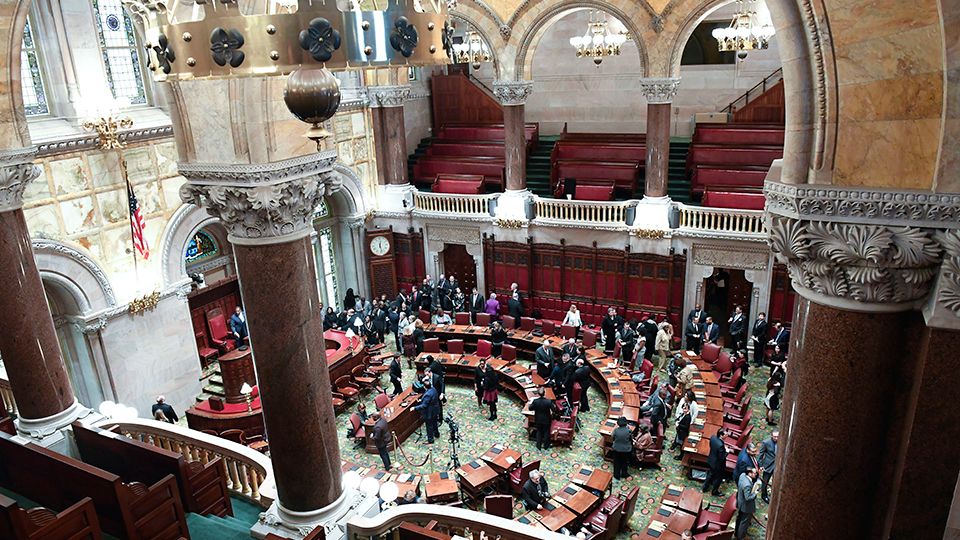The state Assembly and state Senate will unveil their one-house budget resolutions Monday— essentially roadmaps for where state lawmakers want to take negotiations with the governor over the spending plan due at the end of the month.
The proposals are aspirational documents that do not have the force of law, but in a process that can be opaque and lack transparency, it’s a public starting point for the legislature and acts as a counterweight to what Gov. Andrew Cuomo has proposed.
This is also a different kind of budget year under Cuomo, with lawmakers seeking to assert more authority over how money is spent.
Here’s a look at where things stand with three weeks to go until start of the new fiscal year:
Education
The education budget battles in recent years have been about policy: How teachers and principals should be evaluated, whether the cap on charter schools should be increased, and how long to extend mayoral control of New York City schools. This year, the fight is primarily shaping up to be about money. Lawmakers, as they have typically done in the past, want to increase spending, but this year, many are newly emboldened to push for even more money than Cuomo has proposed. They’re backed by education advocates who have long called for adding $2 billion in spending in direct aid for schools. Those advocates have allies like Sen. Robert Jackson (D-31) in office. Cuomo earlier this year countered with a proposal that would change the state’s funding formula, seeking to help poor, underfunded schools within districts.
Health Care
The governor all but dared lawmakers to pass a single-payer health care bill when speaking to The Atlantic. Cuomo has said he would support a single-payer bill on the federal level, but is skeptical how it would work for New York, which is increasingly becoming cash-strapped. The bill’s sponsors insist a single-payer program for the state would ultimately save money by reducing a costly private insurance bureaucracy. Amendments to Cuomo’s budget last month included proposals to slow the growth of spending under Medicaid and Cuomo wants to bolster the Affordable Care Act by enshrining the measure into state law, such as the state’s health insurance marketplace.
Property Tax Cap
The state Senate last month passed a standalone bill that would make the cap on property tax increases a permanent one. The provision does not expire this year, but has historically been linked to rent control regulations for New York City. Those are set to sunset, and Cuomo has signaled he wants to include both in a final budget agreement. The Assembly is yet to take up a tax cap bill and the chamber has in the past included members supportive of making changes, such as no longer capping increases at the rate of inflation. Those changes have been sought by teachers unions and local government advocates. Nevertheless, the vast majority of school districts and local municipalities have been able to budget within the cap since it was first approved in 2011.
Marijuana
The issue is increasingly becoming a cross-section of the budget: Health, criminal justice reform, local control, even mass transit, are being affected by it. Both legislative budget proposals are expected to include a version of a program that would legalize marijuana. Lawmakers want to allow people to be able to grow small amounts of the plant; Cuomo envisions a plan that would create a commercial retail structure regulated similarly to alcohol. Cuomo also wants local governments to be able to opt out of marijuana retail and use some of the sales tax revenue generated to pay for mass transit in New York City. Lawmakers have said they want the money to be prioritized for communities affected by stiff drug laws.
The MTA
Congestion pricing is increasingly becoming just one component of a very complex plan that could also include marijuana sales tax revenue, collecting sales tax on out-of-state online purchases, and even a tax on second homes worth more than $5 million, as well as tolls below 61st Street in Manhattan. At stake is finding a dedicated funding source for mass transit and the MTA in New York City in order to begin the costly process of fixing and improving the city’s subways while also reducing the glut of car traffic. Suburban lawmakers, as they have done in previous congestion pricing iterations, have raised concerns with impact of the proposal on their constituents and want some form of buy-in, such as more money for commuter rail services like the Long Island Rail Road and Metro North.
Campaign Finance
Assembly Speaker Carl Heastie last week announced the votes aren’t there in his chamber just yet for the public financing of campaigns. This led to something of an outcry from the progressive advocates, including Zephyr Teachout, who had hoped an all-Democratic Legislature would lead to the program’s approval. The Senate is expected to include public financing in its budget plan. Cuomo wants public financing, along with lower donor limits and a ban on corporate contributions in the final budget agreement.
The Legislative Dynamic
It’s very different this year with a large Democratic majority in the state Senate. A lot of policy that would still be left outstanding — gun control, abortion rights, LGBT issues — have already been taken up. Meanwhile, the relationship between lawmakers and Cuomo has been an increasingly truculent one given the fallout of the failed Amazon project in Queens and the lingering discontent over the results of a pay raise commission. Cuomo’s ace in the hole for resolving the budget remains the phase-in of a pay increase that would not go into effect if the budget goes past the April 1 due date. Lawmakers, however, insist this isn’t a factor in the budget talks.



